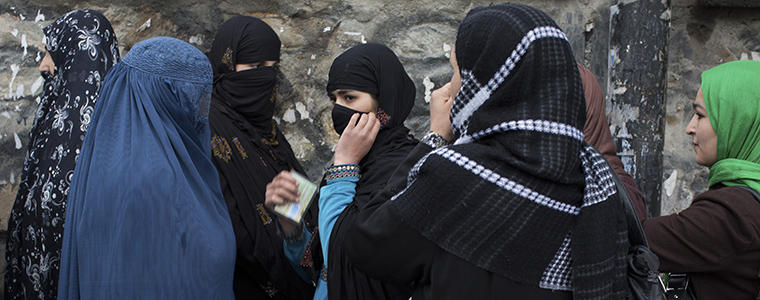The risk of backsliding in the status of women in Afghanistan after 12 years of significant strides is one of the biggest question marks surrounding the country's prospects amid the drawdown of the U.S.-led military coalition. Tim Luccaro, who has worked on traditional dispute resolution, women's access to justice and nonviolent conflict resolution in Afghanistan since 2010, considers what steps will be needed to secure the gains that have been made.

A reduction of international military forces usually translates into a drop in world attention and civilian funding, and Afghan women leaders have appealed to foreign donors to continue their support. The U.S. Institute of Peace has produced a series of analytical reports and articles in recent months laying out the hurdles ahead in Afghanistan, including in finances and governance.
Luccaro, who served as USIP's senior program officer in Afghanistan for three years, co-authored the report "Women's Access to Justice in Afghanistan" with Erica Gaston, a human rights lawyer with seven years of experience in programming and research in Afghanistan who also was a senior program officer at USIP until recently. Here, Luccaro looks at the prospects for further advances in the role of women, men, and the country's youth.
What do you view as the most critical area of reform that will protect the gains made by Afghanistan's women in the past 12 years while ensuring continued progress in their social and political status?
TL: Any time we are talking about a change in cultural norms and ensuring that there is really a radical shift in the way that entire communities (including government officials) view women, we need to think about building new models of understanding gender. That means broadening education to be sure that curricula in state and madrassa schools include awareness about rights and civic roles from a very young age. We've seen many positive changes in statutory and constitutional protections for women in Afghanistan in the last 12 years. The biggest challenge now is not necessarily technical or purely legalistic. While there has been a dispiritingly conservative trend in legislative reforms over the last two years with regards to women's rights protections and equality, the biggest thing needed within the existing legal framework is to ensure that we are supporting local shifts in understanding that recognize and support all Afghan citizens' legal rights.
What was the most challenging aspect of collecting data for the report on women's access to justice?
TL: It is very easy to underestimate the absolute isolation and poverty of many communities in Afghanistan if you have never traveled around the country. Access to communities was severely limited by the very basic difficulty of travel and getting to the places where we wanted to speak with women and community members.
On top of that, there is a very rational unease in many communities with foreigners, both internationals, as well as Afghans from outside the community, especially when the strangers are asking questions about what are personal and problematic issues. We were fortunate that our lead field researchers, Farid Bayat and Reyhaneh Hussaini, were so adept at navigating these community dynamics and really establishing the trust and confidence of communities in such a way that we were able to find some incredibly illustrative stories of individual women's struggles and challenges.
Did you encounter resistance from the justice system?
TL: Quite a few individuals within the formal justice system were suspicious about the reasons for our work. I think so often, the international media and organizations working on women's rights in Afghanistan paint a portrait of a terribly macabre landscape for women, which is sadly too often accurate. After 12 years of both government officials and community leaders – who were predominantly male, though not entirely – all being cast as villains in this tragedy, there is deep-held distrust of those who are working on justice-related issues. The challenge, then, is identifying and supporting those individuals who are looking for an alternative path, who are the positive "heretics" within an otherwise conservative or repressive system.
What impact, if any, will the departure of coalition forces have on the marginal gains made over the past decade?
TL: It still remains to be seen how drastically women's gains will contract with the accompanying reduction in the levels of aid and media attention that has been focused on Afghanistan in the last 12 years. We were hearing that the biggest threat to women's mobility, along with access to economic and educational opportunities, is deterioration in security in communities. Whether that deterioration is real or perceived, as communities see a decrease in security, there is a direct correlation to women's freedom of movement. This will be the most immediate consequence of the withdrawal.
On a longer horizon, with smart assistance and programming, there is really an opportunity to build on the gains that have been made. I think that there are now enough people in the country who recognize the value in greater equality for women, and the absolute necessity of ensuring their fundamental rights are protected, that the emerging generation of Afghan leaders will continue to build upon the moderate successes so far. We've always argued that the necessary changes are generational in scope, and if we strategically focus resources, even though they are diminishing, on further entrenching these cultural shifts and promoting progressive visions of gender equality in Afghanistan, we may actually see an expansion of women's rights.
What gives you hope?
TL: There are so many young people who have had the benefit of a relatively secure environment to pursue their education – both men and women – that there is a hope that the emerging generation of Afghan leaders will chart a path for the country that is able to navigate the historically overlapping cultural, national and religious identities. I think there are a lot of progressive, intelligent young Afghans who will be able to find a solution that is in the best interests of all citizens of the country.